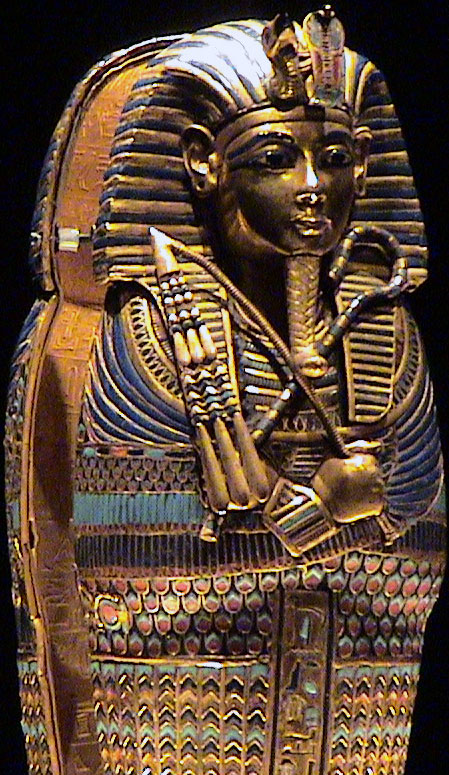Crook and flail on:
[Wikipedia]
[Google]
[Amazon]
 The crook and flail (''heka'' and ''nekhakha'') were symbols used in ancient Egyptian society. They were originally the attributes of the deity
The crook and flail (''heka'' and ''nekhakha'') were symbols used in ancient Egyptian society. They were originally the attributes of the deity
 The crook and flail (''heka'' and ''nekhakha'') were symbols used in ancient Egyptian society. They were originally the attributes of the deity
The crook and flail (''heka'' and ''nekhakha'') were symbols used in ancient Egyptian society. They were originally the attributes of the deity Osiris
Osiris (, from Egyptian ''wsjr'', cop, ⲟⲩⲥⲓⲣⲉ , ; Phoenician: 𐤀𐤎𐤓, romanized: ʾsr) is the god of fertility, agriculture, the afterlife, the dead, resurrection, life, and vegetation in ancient Egyptian religion. He wa ...
that became insignia of pharaonic
Pharaoh (, ; Egyptian: '' pr ꜥꜣ''; cop, , Pǝrro; Biblical Hebrew: ''Parʿō'') is the vernacular term often used by modern authors for the kings of ancient Egypt who ruled as monarchs from the First Dynasty (c. 3150 BC) until the ...
authority. The shepherd's crook
A shepherd's crook is a long and sturdy stick with a hook at one end, often with the point flared outwards, used by a shepherd to manage and sometimes catch sheep. In addition, the crook may aid in defending against attack by predators. Wh ...
stood for kingship and the flail
A flail is an agriculture, agricultural tool used for threshing, the process of separating cereal, grains from their husks.
It is usually made from two or more large sticks attached by a short chain; one stick is held and swung, causing the othe ...
for the fertility of the land.
The earliest known example of a crook is from the Gerzeh culture
The Gerzeh culture, also called Naqada II, refers to the archaeological stage at Gerzeh (also Girza or Jirzah), a prehistoric Egyptian cemetery located along the west bank of the Nile. The necropolis is named after el-Girzeh, the nearby contem ...
(Naqada II), and comes from tomb U547 in Abydos . By late Predynastic times, the shepherd's crook was already an established symbol of rule. The flail initially remained separate, being depicted alone in some earliest representations of royal ceremonial. Approximately by the time of the Second Dynasty
The Second Dynasty of ancient Egypt (or Dynasty II, c. 2890 – c. 2686 BC) is the latter of the two dynasties of the Egyptian Archaic Period, when the seat of government was centred at Thinis. It is most known for its last ruler, K ...
the crook and flail became paired.
The only extant pharaonic examples of both the crook and flail come from the Tomb of Tutankhamun
The tomb of Tutankhamun, also known by its tomb number, KV62, is the burial place of Tutankhamun (reigned c. 1334–1325 BC), a pharaoh of the Eighteenth Dynasty of ancient Egypt, in the Valley of the Kings. The tomb consists of four chambers ...
. Their staffs are made of heavy bronze covered with alternating stripes of blue glass
Cobalt glass—known as "smalt" when ground as a pigment—is a deep blue coloured glass prepared by including a cobalt compound, typically cobalt oxide or cobalt carbonate, in a glass melt. Cobalt is a very intense colouring agent and very litt ...
, obsidian, and gold, while the flail's beads are made of gilded wood.
Theories on significance
Traditionally crossed over the chest when held, they probably represented the ruler as a shepherd whose beneficence is formidably tempered with might. In the interpretation ofToby Wilkinson
Toby Alexander Howard Wilkinson, (born 1969) is an English Egyptologist and academic. After studying Egyptology at the University of Cambridge, he was Lady Wallis Budge Research Fellow in Egyptology at Christ's College, Cambridge (1993 to 199 ...
, the flail used to goad livestock, was a symbol of the ruler's coercive power: as shepherd of his flock, the ruler encouraged his subjects as well as restrained them.
Still another interpretation, by E. A. Wallis Budge, is that the flail is what was used to thresh grain.
References
See also
*Sekhem scepter
The sekhem scepter is a type of ritual scepter in ancient Egypt. As a symbol of authority, it is often incorporated in names and words associated with power and control. The sekhem scepter (symbolizing "the powerful") is related to the ('')'' sc ...
*Was scepter
Was or WAS may refer to:
* ''Was'', a past-tense form of the English copular verb ''to be''
People
* David Was (born c. 1952), the stage name of multi-instrumentalist and songwriter David Weiss
* Don Was (born 1952), the stage name of bass guita ...
*Pharaoh-seated, with flail & red crown (hieroglyph)
The Pharaoh-seated, with flail & red crown hieroglyph is Gardiner sign listed no. A46, in the category of: ''man and his occupations;'' specifically, there are many varieties in the category showing the pharaoh. The King (Pharaoh) can typicall ...
{{Ancient Egyptian religion footer, state=collapsed
Ancient Egyptian symbols
Regalia
Pharaohs
Osiris
Gerzeh culture